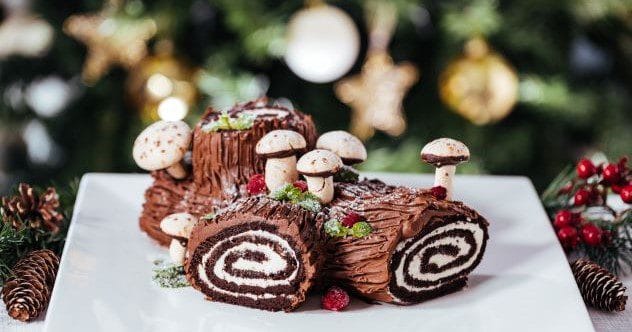Christmas is a season brimming with cherished traditions. Decorating trees, hanging stockings, and sipping eggnog are just a few customs that make this time of year special. But have you ever wondered where these traditions come from? Many have surprising historical origins, stretching back centuries and evolving through pagan rituals, marketing strategies, and cultural adaptations. Let’s unwrap the hidden stories behind ten beloved Christmas traditions.
From the ancient roots of mistletoe to the modern twist on advent calendars, prepare to discover the unexpected journeys that have shaped the holiday season we celebrate today!
Mistletoe: A Pagan Symbol of Fertility and Peace
We often associate mistletoe with romance and stolen kisses. But its history goes way back to ancient pagan times. The Druids believed mistletoe had magical powers, protecting against evil spirits and boosting fertility. They’d harvest it with golden sickles during winter solstice ceremonies, using it in rituals for a good harvest and protection in the coming year.
Kissing under the mistletoe? That likely comes from Norse mythology. Legend says the goddess Frigg declared mistletoe a symbol of love after it revived her son, Balder. This idea of peace and affection stuck around, evolving into the romantic tradition we know today, popularized by the Victorians.
Christmas Stockings: A Charitable Legend of Saint Nicholas
Hanging stockings by the fireplace? Thank Saint Nicholas! A 4th-century legend tells of a poor widower with three daughters, unable to afford their dowries. Saint Nicholas secretly dropped bags of gold down their chimney one night, which landed in the girls’ stockings drying by the fire.
This act of kindness became linked to Christmas gift-giving, and stockings became a tradition across Europe. In the 19th century, Clement Clarke Moore’s poem, “Twas the Night Before Christmas,” further cemented stockings as a Christmas staple in the United States, filled with toys and treats.
Christmas Trees: A Fusion of Pagan and Christian Traditions
The modern Christmas tree blends pagan and Christian beliefs. Ancient Romans used evergreen branches during Saturnalia, and medieval Germans decorated fir trees for the winter solstice, symbolizing hope and eternal life.
The Christian take on the Christmas tree often credits Martin Luther in 16th-century Germany. Inspired by stars shining through a fir tree, he brought one home and decorated it with candles. The tradition spread through Europe and gained popularity in England thanks to Queen Victoria and Prince Albert. German immigrants then brought the practice to America, making it a lasting holiday symbol.
Eggnog: A Colonial Adaptation of a Medieval Drink
Eggnog’s story begins in medieval Britain with a drink called “posset.” It was made by mixing hot milk with ale or wine and adding spices. Wealthy families added eggs and cream, turning it into a luxurious treat for special occasions.
When European settlers brought the drink to America, rum became the alcohol of choice, cheaper and easier to get than imported wine or brandy. Eggnog became a Christmas favorite, its richness symbolizing abundance and celebration. It’s remained popular, even inspiring regional variations like Puerto Rico’s coquito.
Candy Canes: Religious Symbol or Sweet Marketing Ploy?
We often hear candy canes have religious meanings – the shape representing a shepherd’s crook and the colors symbolizing Christ’s blood and purity. But that’s mostly a modern idea. The first candy canes, from 17th-century Germany, were plain white sticks of sugar candy given to kids during nativity plays to keep them quiet.
Red stripes and peppermint flavor appeared in the 19th century, likely to make the candy more appealing to customers. By the 20th century, candy canes were a Christmas staple, thanks to both clever marketing and their supposed religious ties.
Santa’s Sleigh: Borrowed from Norse Mythology
Santa flying through the night in a sleigh pulled by reindeer? That image comes from Norse mythology. In the pagan Yule tradition, Odin, the Norse god, rode across the sky on an eight-legged horse named Sleipnir during midwinter. Children would leave food for Sleipnir, and Odin would give them gifts.
As Christianity spread, Odin’s image blended with St. Nicholas, creating Santa Claus. The sleigh and reindeer were later made popular by Clement Clarke Moore’s poem “Twas the Night Before Christmas” in 1823. Rudolph, the red-nosed reindeer, joined the story in 1939 as a marketing campaign. It’s a magical mix of ancient stories and modern advertising!
Gift Wrapping: A Japanese Tradition Turned Western Staple
We think of gift wrapping as a Western custom, but it started in Asia. In Japan, wrapping gifts in furoshiki cloths dates back to the 8th century, a practical and personal way to protect the gift. Similarly, in China, silk cloths wrapped gifts, symbolizing good fortune and respect.
In the West, modern gift wrap became popular by accident in 1917. Joyce and Rollie Hall, of Hallmark, ran out of tissue paper during Christmas and sold decorative envelope lining paper instead. It was a hit! By the mid-20th century, gift wrap was a holiday staple, with colorful designs and ribbons turning gift-giving into a visual treat.
Advent Calendars: From Religious Devotion to Chocolate Treats
Advent calendars began in 19th-century Germany, helping families count down to Christmas. Early versions were homemade, using candles, chalk marks, or religious images. In 1908, Gerhard Lang created the first commercial advent calendar, with doors revealing Bible verses or festive pictures, focusing on religious reflection.
The chocolate-filled advent calendar appeared in the mid-20th century, as companies like Cadbury catered to kids. Today, advent calendars offer everything from toys to beauty products, showing how the tradition has changed from its religious roots to a commercialized part of the holiday season.
Christmas Cards: A Victorian Innovation
The Christmas card started in 1843, thanks to Sir Henry Cole. He wanted an easier way to send holiday greetings. Cole commissioned the first commercial Christmas card, featuring a festive family scene. These cards quickly became popular among the Victorian upper class.
Affordable postage stamps made sending cards easier, and the trend spread across Europe and the United States. By the early 20th century, companies like Hallmark mass-produced Christmas cards. While emails and social media have reduced their popularity, they remain a cherished tradition for many.
The Yule Log: From Pagan Fire Ritual to Dessert
The Yule log comes from ancient Scandinavia, a key part of pagan midwinter celebrations. Families would decorate a huge log and burn it in the hearth during the winter solstice, honoring the Norse gods. The fire symbolized warmth, protection, and the return of the sun. Ashes were kept as charms for good luck.
When Christianity spread, the Yule log became part of Christmas traditions. In the 19th century, French pastry chefs made it into the bûche de Noël, a sponge cake rolled to look like a log. This dessert became a popular Christmas treat, blending ancient customs with modern celebrations.
These ten traditions are just a glimpse into the fascinating history behind Christmas. Each custom carries a unique story, shaped by culture, religion, and time. As you celebrate this year, take a moment to appreciate the rich and surprising origins of these beloved traditions.
What are your favorite Christmas traditions? Share your thoughts in the comments below!










